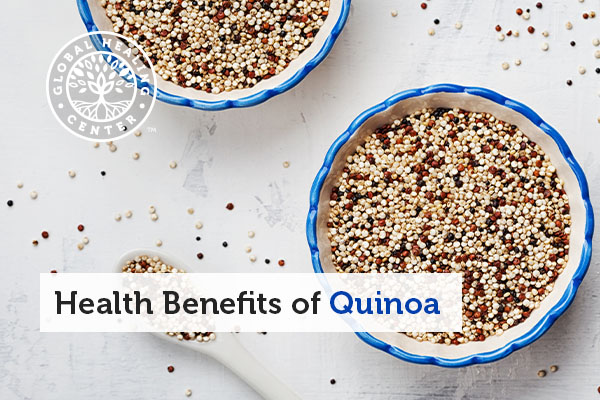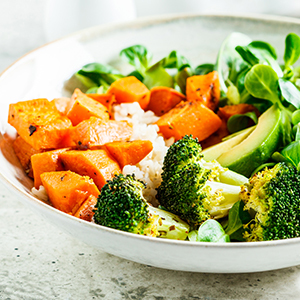
Quinoa is a crop that's primarily grown in Peru. It's often described as a grain although, technically, is not one and is actually more closely related to spinach and beets. It's grain comparisons, however, are the result of its edible seeds, which are milled and used in a fashion similar to flour. Quinoa has been a dietary staple in several South American countries for many years. Recently, it has become much more popular in the United States, Canada, and Asia because of its healthful properties, range of uses, and lack of gluten.
Quinoa is Very Nutritious
Quinoa is a fantastic food choice for many reasons. It has a high protein quality and several other nutritional properties. Quinoa has a great amino acid balance and near-ideal proportion of omega-6. It is an important source of minerals and vitamins, especially vitamin E. Additionally, quinoa contains polyphenols, phytosterols, and flavonoids, which are thought to offer nutraceutical benefits; and it has high antioxidant activity. Quinoa is also very usable; it has functional characteristics such as solubility, freeze stability, and gelation that allow it to be used in many ways. [1] [2]
Quinoa is a Satisfying Food
A food's satiety is its ability to make you feel full. Believe it or not, many of the very tasty foods that are popular in the modern western diet lack this quality – which is probably why it's a little too easy to eat an entire bag of chips in one sitting. The Department of Food Science and Microbiology at the University of Milan compared the satiety of alternative crops, including quinoa, with wheat and rice. The result? The satiety for alternative crop foods was highest; white bread was the least satisfying food. Because quinoa satisfies your appetite and satisfies it quicker than less nutritious food, it has garnered attention for its potential to impact eating behavior (specifically, making you eat less). [3]
Quinoa is Excellent for a Gluten-Free Diet
Gluten sensitivity and allergies are increasingly common; one of the most common related conditions is celiac disease. Celiac disease is a chronic redness and irritation of the intestines and it's triggered by dietary gluten. Persons with celiac disease simply cannot consume gluten-containing foods in any amount; the only solution for relief is to follow a gluten free diet. [4]
Because persons with celiac disease have to follow a limited diet, it's relatively common for them to experience minor nutritional deficiencies. The Department of Gastroenterology at King's College London and Columbia University's Celiac Disease Center both recommend alternative grain-based foods, like quinoa, as an important source of nutrients for patients with celiac disease. [5] [6]
Italy's National Research Council investigated and confirmed the safety of quinoa, along with millet, tef, and amaranth, for persons with celiac disease. [7]
Try Quinoa!
Many foods today are loaded with unhealthy, junk carbohydrates and contribute to the incidence of diabetes, heart disease, and digestive ailments. Many people have improved their life by incorporating quinoa and whole grains into their diet. [8] Quinoa is available at many health food stores, and even some mainstream grocery stores. It costs a little more but the benefits are worth it – we're talking about your health.
References (8)
- Abugoch James LE. Quinoa (Chenopodium quinoa Willd.): composition, chemistry, nutritional, and functional properties. Adv Food Nutr Res. 2009;58:1-31. doi: 10.1016/S1043-4526(09)58001-1.
- Ranilla LG, Apostolidis E, Genovese MI, Lajolo FM, Shetty K. Evaluation of indigenous grains from the Peruvian Andean region for antidiabetes and antihypertension potential using in vitro methods. J Med Food. 2009 Aug;12(4):704-13. doi: 10.1089/jmf.2008.0122.
- Berti C, Riso P, Brusamolino A, Porrini M. Effect on appetite control of minor cereal and pseudocereal products. Br J Nutr. 2005 Nov;94(5):850-8.
- Saturni L, Ferretti G, Bacchetti T. The gluten-free diet: safety and nutritional quality. Nutrients. 2010 Jan;2(1):16-34. doi: 10.3390/nu20100016. Epub 2010 Jan 14.
- Lee AR, Ng DL, Dave E, Ciaccio EJ, Green PH. The effect of substituting alternative grains in the diet on the nutritional profile of the gluten-free diet. J Hum Nutr Diet. 2009 Aug;22(4):359-63. doi: 10.1111/j.1365-277X.2009.00970.x. Epub 2009 Jun 10.
- Zevallos VF, Ellis HJ, Suligoj T, Herencia LI, Ciclitira PJ. Variable activation of immune response by quinoa (Chenopodium quinoa Willd.) prolamins in celiac disease. Am J Clin Nutr. 2012 Aug;96(2):337-44. doi: 10.3945/ajcn.111.030684. Epub 2012 Jul 3.
- Bergamo P, Maurano F, Mazzarella G, Iaquinto G, Vocca I, Rivelli AR, De Falco E, Gianfrani C, Rossi M. Immunological evaluation of the alcohol-soluble protein fraction from gluten-free grains in relation to celiac disease. Mol Nutr Food Res. 2011 Aug;55(8):1266-70. doi: 10.1002/mnfr.201100132. Epub 2011 Jun 28.
- Dixit AA, Azar KM, Gardner CD, Palaniappan LP. Incorporation of whole, ancient grains into a modern Asian Indian diet to reduce the burden of chronic disease. Nutr Rev. 2011 Aug;69(8):479-88. doi: 10.1111/j.1753-4887.2011.00411.x.
†Results may vary. Information and statements made are for education purposes and are not intended to replace the advice of your doctor. If you have a severe medical condition or health concern, see your physician.







